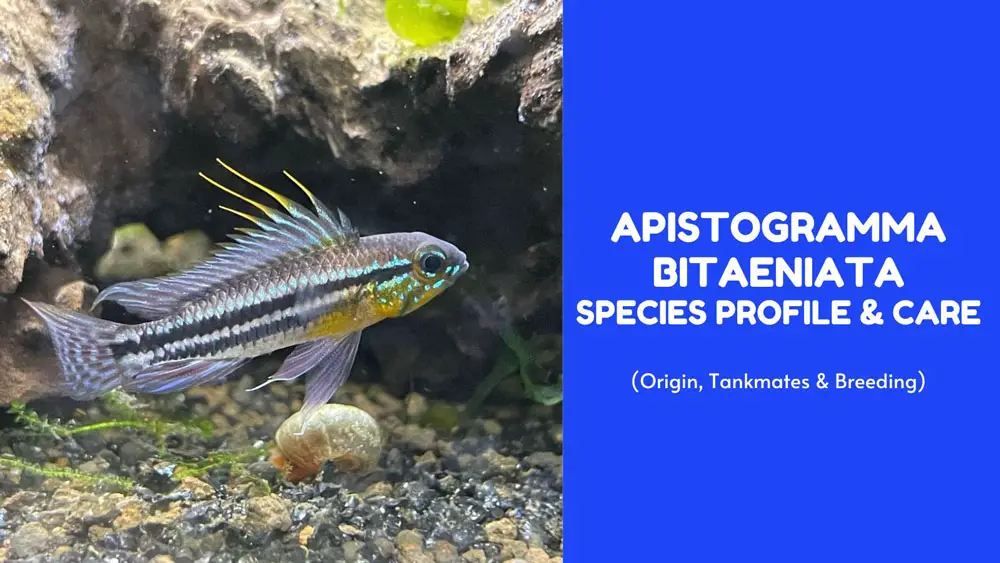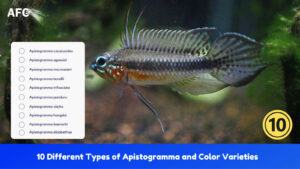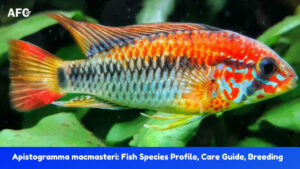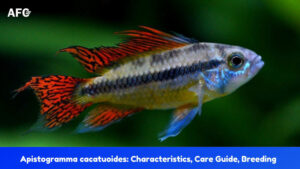Apistos make up a very large family of dwarf cichlids known for their broad spectrum of colors.
Some species are known for their exclusive blackwater habitats, the banded dwarf cichlid, Apistogramma bitaeniata, is one of them.
Plus, they’re considered somewhat “advanced” Apistogramma species with a semi-aggressive temperament, making them more of an intermediate-level fish.
Before you make the commitment, let’s learn more about this dazzling Apisto and how to best meet their special care requirements.
Species Overview
| Scientific Name: | Apistogramma bitaeniata |
| Common Name: | Banded Dwarf Cichlid, Two-striped Apisto |
| A-number: | A211, A212, A213, A214, A215, A216, 218 |
| Origin: | Brazil, Peru, Colombia |
| Family: | Cichlidae |
| Lineage: | trifasciata |
| Group: | bitaeniata |
| Max Size: | Males: 3 inches (7.5 cm); Females: 2 inches (5 cm) |
| Social: | Semi-aggressive |
| Care: | Intermediate |
| Lifespan: | 2 ~ 5 years |
| pH: | 4.0 – 6.0 |
| Temperature: | 73-79° F (23-26 °C) |
| Hardness: | up to 5 degrees |
| TDS: | < 20 |
| Diet: | Carnivore |
| Tank Size: | 20 gallons |
Distribution & Habitat
The Apistogramma bitaeniata is native to a relatively wide range in South America, including the Rio Tefé to the mouth of Rio Tapajós in Brazil and the lower Río Ucayali of Peru to the Colombian Amazon.
These two primary geographical forms, Brazilian and Peruvian populations, exhibit various color morphs, commonly referred to as “red,” “blue,” “orange,” and “yellow” among Apisto enthusiasts.
They inhabit quite shallow streams, tributaries, and pools with little or no water movement. The bottom consists of branches, with accumulations of fallen leaves on the ground.
As a result, such water bodies are characterized principally by low levels of dissolved mineral content (low GH) and high amount of humic dissolved acids and tannins (low pH).
Names & Markings
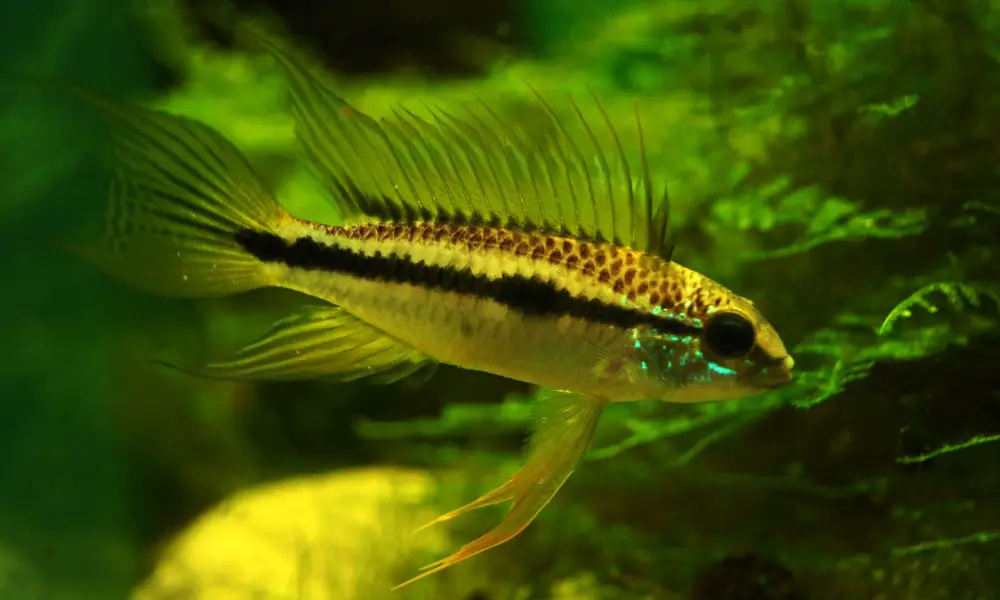
Apistogramma bitaeniata was scientifically documented by Jacques Pellegrin, a French zoologist, in 1936. This scientific name is a combination of two Latin words: “bi,” meaning “two,” and “taenia,” meaning “band,” which refers to the fish’s two longitudinal stripes.
As you probably already know, the lateral band is one of the most important characteristics for identifying Apistogramma species. Some species show a narrow zig-zag lateral band, while others may have a broad one that breaks into a distinct lateral spot on the tail.
Aptly named the Two-striped Apisto or Banded Dwarf Cichlid, this slender-bodied species has two thick horizontal stripes along their bodies. The first stripe runs across the lateral line from the snout to the dorsal fin, while the second stripe is just below it on the abdomen.
Like many other described Apistogramma species, certain populations of Apistogramma bitaeniata, particularly those popular in aquariums, have been assigned ‘A’ numbers to distinguish between different localities.
| A-number | Locality |
|---|---|
| A211 | Río Nanay (Peru) |
| A212 | Río Yavari (Brazil/Peru) |
| A213 | Río Tefé (Brazil) |
| A214 | Río Manacapuru (Brazil) |
| A215 | Río Tefé and Tapajós (Brazil) |
| A216 | Río Madeira (Brazil) |
| A218 | Río Itaya (Peru) |
How to identify an Apistogramma bitaeniata?
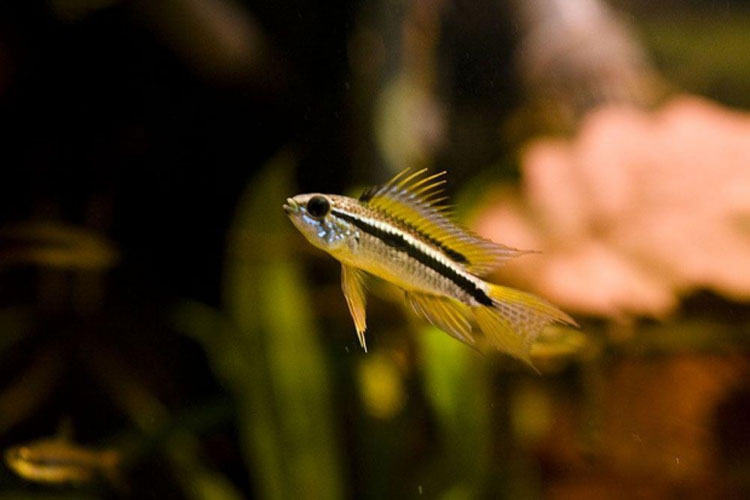
Luckily, it’s fairly easy to distinguish Apistogramma bitaeniata from other Apistogrammas if you have read through this suggested phylogeny for Apistogramma species groups by Mike Wise (2020) [1].
According to his proposed Apistogramma phylogeny, Apistogramma bitaeniata (more accurately referred to as the Apistogramma bitaeniata complex) belongs to the bitaeniata Group in the agassizii Sublineage, which is one part of the trifasciata Lineage.
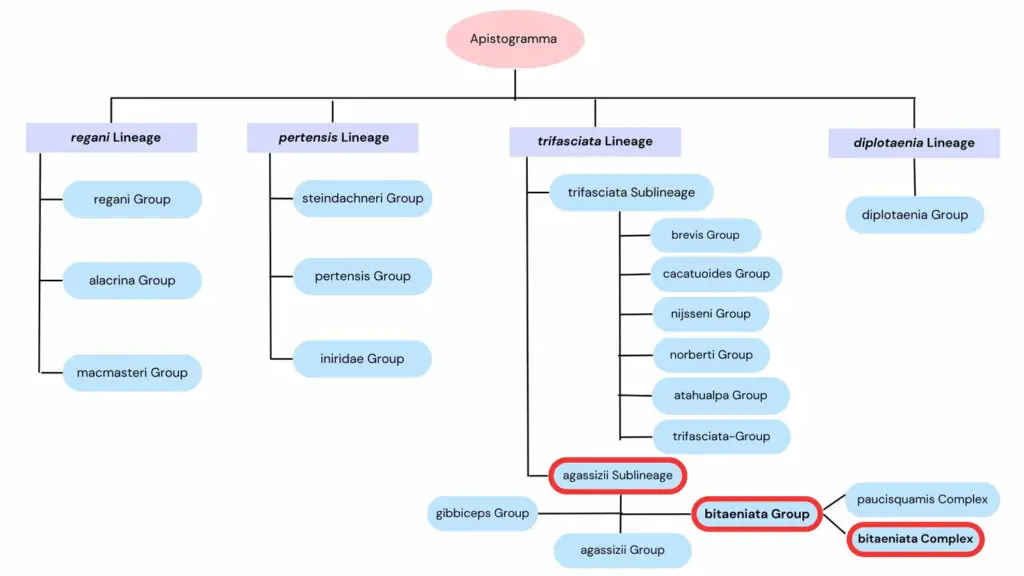
The bitaeniata Complex can be recognized by the following traits:
- One prominent abdominal stripe.
- A lyre-shaped caudal fin that is double-tipped with cirri.
- The dorsal fin is black at the base and has a yellow-tipped margin.
The bitaeniata Complex is often mistaken for its close relative, the paucisquamis Complex. Sporting the same wide lateral band, what primarily separates the two complexes is that the latter has two or three bands on the abdomen, and the caudal fin is typically larger.
Brazilian Vs. Peruvian Apistogramma bitaeniata
As is true for many cichlid fish, the geographical populations of Apistogramma bitaeniata have slight variations in color, pattern, and size.
The Brazilian populations of A. bitaeniata typically exhibit two identical stripes on a slender body. In contrast, the Peruvian populations tend to have a less obvious abdominal stripe and a slightly stockier body.
Additionally, the difference in the color of the gill cover (operculum) is also noticeable; males in the Brazilian populations have a richer yellow color with a bluish shine, while those in the Peruvian specimens display many blue stripes and spots.
Banded Dwarf Cichlid Size
The banded dwarf cichlid (Apistogramma bitaeniata) is a slightly larger Apistogramma species; males grow up to 3 inches (7.5 cm) long, and females reach about 2 inches (5 cm).
Set Up an Aquarium for Apistogramma bitaeniata
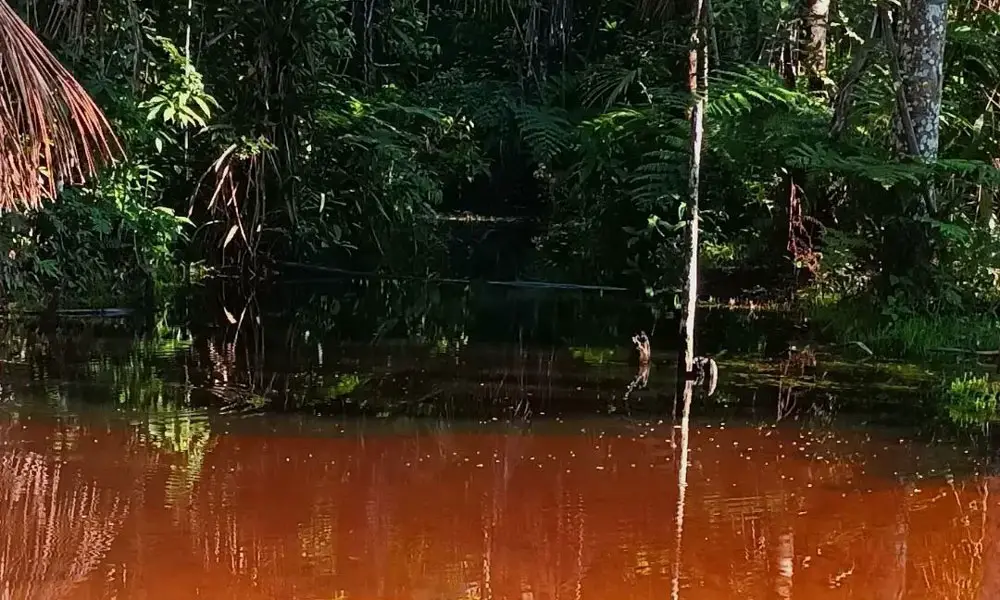
As mentioned before, the shallow, clean water from which this blackwater Apisto originates is naturally soft and acidic, with a pH of 4.0 to 5.5 and a hardness level of 0.2 to 0.6º dGH.
To bring out their bright coloration and breed successfully, Apistogramma bitaeniata needs to be housed in an aquarium set up to mimic the water quality parameters of its natural habitat.
Tank Size
Depending on your setup, a breeding tank or a community display tank, a breeding pair (or a trio) of Apistogramma bitaeniata can comfortably be housed in a 20-gallon Long (30″ x 12″ x 12″) tank.
For a community display tank, having large groups consisting of 3 males and at least 5 females in a 75-gallon (48″ x 18″ x 21″) tank is highly recommended. The more you have, the better the chance of observing their social behavior.
In either case, the length of the tank is more important than the height, as all Apistos have a preference for a large footprint.
Water Conditions
Although optimal water parameters are important for an A. bitaeniata fish tank, these fish are not overly demanding regarding their water parameters.
Wild-caught individuals may require slightly different water conditions, depending on their collection sites. For example, the Río Nanay form (A211) lives in an environment with a higher mineral (iron) content compared to other forms. On the other hand, specimens from forest blackwater pools enjoy typical darker and clearer waters.
That being said, the best water conditions for your fish may vary slightly from one locality to another; however, in general, we should aim to provide them with the following range of water parameters:
- Temperature: 73-79° F (23-26 °C)
- pH: 4.0 – 5.5 (Around 5 is ideal)
- Hardness: up to 5 degrees
- Conductivity: < 50 µS/cm (or TDS < 20)
Banded dwarf cichlids are more susceptible to bacterial diseases than most Apistos, and the commonly used chemical dyes such as Methylene Blue and Methylene Green can be quite toxic. Therefore, it is vital to keep their tank clean and monitor water parameters regularly.
Plants, Substrate & Lighting
Apistogramma bitaeniata lives in shallower areas surrounded by shady trees and rotting woods. Thus, they would appreciate a tank with low lighting and live aquarium plants, especially floating ones that can dim lighting and offer hiding spots. The plants must tolerate low lighting conditions and acidic water.
In addition, Apistos are also known to be bottom dwellers, so a sandy substrate with lots of fallen leaves can make them feel more comfortable. A darker background can also help bring out their coloration.
Since Apistogramma bitaeniata is not a very aggressive fish, providing plenty of hiding spots for the dominant male and females is essential to defeating aggression between them. Live plants are ideal, but bogwoods, upturned flowerpots, PVC pipes, coconut shells, driftwoods, or decorative rock caves can also be used.
What do Apistogramma bitaeniata Eat?
In nature, these dwarf cichlids are considered to be carnivores, mainly feeding on a variety of small aquatic invertebrates.
To make sure they get a full range of vitamins and essential nutrients, they should be fed live or frozen food, including newly hatched baby brine shrimp, black/white mosquito larvae, daphnia, or small worms. Tank-raised specimens sometimes accept prepared carnivorous flakes and pellets as well.
Remember that the banded dwarf cichlid is a bottom-feeding fish and will only eat food that sinks to the bottom.
Behavior & Tank Mates
Like most members of the trifasciata lineage, Apistogramma bitaeniata is a polygamous species. During the breeding season, a dominant male will attempt to mate with all females in the tank.
They are not overly aggressive fish, but they will show aggression towards subdominant males and females that are not ready to spawn. The key is to provide them with plenty of hiding spots where they can escape, if necessary.
Whether you are setting up a South American community tank or a breeding tank, consider keeping Apistogramma bitaeniata in a harem consisting of one male with at least two females.
In a community tank setup, try keeping them with peaceful dither fishes such as corydoras, small tetras, pencilfish, and otos. Like most carnivores, they will opportunistically snack on invertebrates, such as shrimps and fish fry.
Males Vs. Females Apistogramma bitaeniata
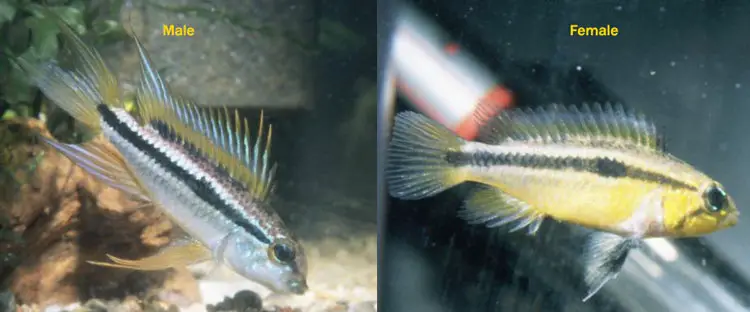
Generally, sexual dimorphism is a common characteristic of polygynous species.
In terms of sexing Apistogramma bitaeniata, the ventral fins of the mature male are longer and more pointed. Males can also be identified by their lyre-shaped caudal fin and bright coloring.
Females have a deeper body with yellow coloring. Their ventral fins are edged in black, but their caudal fin hasn’t many markings.
How to Breed Apistogramma bitaeniata?
If you have never bred an Apisto before, banded dwarf cichlids (A. bitaeniata) can be challenging to reproduce. The main difficulty is to provide them with the correct water parameters and environment.
To start breeding Apistos, you need first to pick a pair of Apistogramma bitaeniata. Unfortunately, it is difficult to locate a breeding pair since most specimens in the pet trade are wild-caught young fish, and there are no noticeable physical differences among the genders.
This species forms only a breeding pair rather than a bonded pair. It’s advisable to keep a large breeding group of three males and four to six females in order to acquire a breeding pair. A trio of a single male with two females is also an option.
If you want to increase your yield, consider pairing older, low-energy males with younger females. This is because the males will be less likely to bother brooding females, who may eat the eggs and offspring.
Once you have a breeding pair, introduce them to a separate, mature breeding tank, which should be well-planted with lots of hiding spots, spawning caves, and a sandy substrate consisting of dried leaf litter. Also, lighting should be subdued.
The water should be soft and acidic; the TDS (Total Dissolved Solids) and pH levels significantly influence the breeding rate. Below are the ideal Apistogramma bitaeniata water parameters for an established breeding tank.
- Temperature: 73-79° F (23-26 °C)
- pH: Around 5
- KH: 0
- GH: 0
- Conductivity: < 10 µS/cm
As these are egg layers, the female will lay eggs (up to 100) on the ceiling of the cave or an overturned flowerpot. At this time, you can remove the male from the spawning tank and let the female take care of them.
Depending on the water temperature, the eggs will hatch within 2 to 3 days, and the fry should start swimming after another week.
For the fry, you can offer hatched brine shrimp nauplii as the first food source, which will help them grow fast and healthy.
Closing Thoughts
Hopefully, you have a better understanding of Apistogramma bitaeniata, a pretty fish that can be seen for sale online with a high price tag.
In general, the banded dwarf cichlid is not recommended for beginners due to its specific water requirements.
You might be interested to know: #1 Easiest Apistogramma species to Take Care of For Beginners
However, if you are willing to commit the time and energy to get it right, Apistogramma bitaeniata can be a rewarding addition to your aquarium.
References:
- Mike Wise October, 2021. A Description of Apistogramma Species-Groups
- Kullander, Sven. 1986. “Cichlid Fishes of the Amazon River Drainage of Peru“. Swedish Museum of Natural History. Cichlids Amazon
- Römer, Uwe. 1994. “Apistogramma mendezi nov. sp. (Teleostei: Perciformes; Cichlidae): description of a new dwarf cichlid from the Rio Negro system, Amazonas State, Brazil”. Aqua: Journal of Ichthyology and Aquatic Biology.
